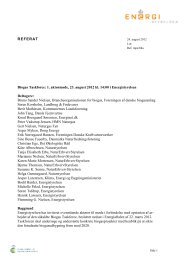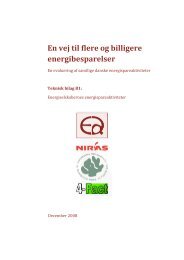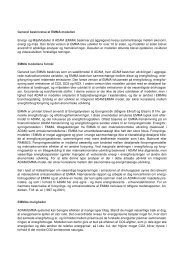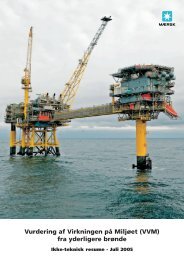Energy Strategy 2050 – from coal, oil and gas
Energy Strategy 2050 – from coal, oil and gas
Energy Strategy 2050 – from coal, oil and gas
You also want an ePaper? Increase the reach of your titles
YUMPU automatically turns print PDFs into web optimized ePapers that Google loves.
Observed climate change<br />
The average temperature in Denmark has increased by 1.5°C <strong>and</strong> precipitation has increased by 15% since systematic<br />
national records began in 1873. The Danish wind climate has also changed over the period. More powerful storms<br />
<strong>and</strong> hurricanes have been observed. In the future even greater climatic changes can be expected, with potential<br />
consequences for the energy system.<br />
The energy need<br />
Up to <strong>2050</strong> it is expected that winters will become warmer, with correspondingly shorter heating seasons. Therefore,<br />
there could be slightly less need for space heating. In contrast, the need for cooling in summer (primarily in offices,<br />
shops etc.) is expected to rise in line with longer heat waves. In new housing, the new building st<strong>and</strong>ards will limit the<br />
need for cooling, but for existing housing there may be increased dem<strong>and</strong> for cooling installations.<br />
<strong>Energy</strong> production<br />
Up to <strong>2050</strong> there are chances of a longer growing season. Together with higher temperatures <strong>and</strong> more precipitation<br />
in the summer, this could lead to more biomass production in both agriculture <strong>and</strong> forestry. As winters become wetter<br />
<strong>and</strong> milder, there will also be good opportunities for more energy production <strong>from</strong> hydropower in Norway <strong>and</strong> Sweden.<br />
In addition a modest increase in wind energy potential is also expected.<br />
Extremes<br />
Towards <strong>2050</strong> more, <strong>and</strong> more powerful hurricanes may disrupt the electricity grid <strong>and</strong> infrastructure <strong>and</strong> mean that<br />
wind turbines will be shut down for short periods. However, it has been estimated that these effects will only have<br />
marginal significance for the security <strong>and</strong> stability of the electricity system. On the other h<strong>and</strong> more, <strong>and</strong> more powerful<br />
hurricanes, in conjunction with more precipitation, could lead to a greater likelihood of massive windfalls <strong>and</strong> this<br />
may affect international markets for chippings <strong>and</strong> wood pellets.<br />
Consequences<br />
Overall, the conclusion is that the expected milder winters in the future will have a modest, yet positive impact on<br />
the Danish energy system <strong>and</strong> the possibilities for the transition to fossil fuel independence, although there is a large<br />
degree of uncertainty regarding the future dem<strong>and</strong> for cooling.<br />
The strategy for fossil fuel independence proposes a number of new energy policy initiatives, which are deemed as<br />
robust in relation to future climate change. Furthermore, there is the ongoing monitoring <strong>and</strong> evaluation of climate <strong>and</strong><br />
energy policy, <strong>and</strong> this will also have to take account of observed climate change.<br />
Box 2.2 Potential changes in the Danish climate <strong>and</strong> the<br />
possible effects on the energy system<br />
<strong>Energy</strong> <strong>Strategy</strong> Energistrategi <strong>2050</strong> <strong>–</strong> <strong>from</strong> <strong>coal</strong>, <strong>2050</strong> <strong>oil</strong> <strong>–</strong> farvel <strong>and</strong> <strong>gas</strong> til to kul, green olie energy. og <strong>gas</strong><br />
21

















